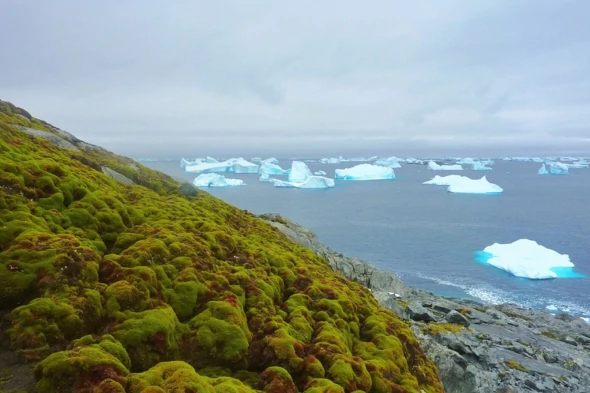A new study has found a steady growth of moss in Antarctica over the last 50 years.
 Plant life on both poles is growing rapidly as the planet warms.
Plant life on both poles is growing rapidly as the planet warms.
A new study has found a steady growth of moss in Antarctica over the last 50 years as temperatures increased as a result of climate change. The study, published yesterday in the journal Current Biology, shows that Antarctica will be much greener in the future, said lead author Matt Amesbury, a researcher at the University of Exeter in the United Kingdom.
The continued retreat of glaciers will make the Antarctic Peninsula, which has been warming at a faster rate than the rest of the continent, a much greener place in the future, Amesbury said.
“It’s a clear sign that the biological response to climate warming is pervasive around the globe,” he said. “The Antarctic Peninsula is often thought of as a very remote and possibly even untouched region, but this clearly shows that the effects of climate change are felt here.”
Amesbury and his fellow researchers used cores of the moss bank to arrive at their conclusion. They looked at 150 years’ worth of data and found clear “changepoints” in the last 50 years that showed the increase of moss cover. Amesbury described the moss growth as a powerful signifier that the region is already undergoing change.
And even though plant life only exists on a tiny fraction of Antarctica, about 0.3 percent, researchers found it is likely to increase significantly as the region warms. As land cover increases and the snow and ice cover decreases, the area also absorbs more heat. That could bring an ecosystem shift to Antarctica that is more in line with what researchers have found in the Arctic.
“The sensitivity of moss growth to past temperature rises suggests that ecosystems will alter rapidly under future warming, leading to major changes in the biology and landscape of this iconic region,” Dan Charman, who led the project at Exeter, said in a statement. “In short, we could see Antarctic greening to parallel well-established observations in the Arctic.”
That echoes research published earlier this year that also shows an increase of plant growth in the Arctic. Scientists once thought tiny marine plants known as phytoplankton could not thrive under sea ice in the frigid Arctic ocean. But thinning ice has allowed them to thrive to such an extent that green patches of ice have been observed. The thinner ice lets sunshine in to previously dark areas, which allows the plankton to grow, and has the potential to dramatically change the ecosystem as animals migrate to the area earlier in pursuit of food.
Those who reject basic climate science have pointed to Antarctica as evidence for their skepticism, claiming that concerns over the transformation of the Arctic because ice cover in Antarctica was growing. The Arctic has shown undeniable signs of climate change by breaking records that show a significant pattern of warming. In recent years, the region has seen new lows for sea ice cover and set stunning temperature records.
Antarctica has been held up as an exception to the understanding of global climate change, but that may be because scientists haven’t understood enough about why it is not warming at the same rate as the Arctic. Researchers say global warming has already transformed the Arctic into a “new state” and that further change is inevitable in the near future. In Antarctica, the observed change has been less dramatic. But that doesn’t disprove the growing understanding of human-caused climate change, said Marc Salzmann, a researcher at the University of Leipzig in Germany.
For one, Antarctica is colder than the Arctic. But it also has a much thicker ice cover, thousands of feet thick in some areas, compared to Arctic sea ice that is just dozens of feet thick. The average elevation in Antarctica is more than a mile above sea level. That high land surface area could be why the melting in Antarctica is less dramatic, a separate study published yesterday in the journal Earth System Dynamics found. One reason is that the transfer of warmer winds blowing into the region from lower latitudes is partially obscured by the mountains and ice sheets. The higher elevation of Antarctica also allows less room for carbon dioxide and water vapor.
That difference in land height accounts for about 56 percent of the difference in the rates of warming in Antarctica compared to the Arctic.
“The general public has generally heard about the Arctic warming rapidly, and so if somebody asks themselves why Antarctic has not yet warmed so much, this actually gives the explanation,” Salzmann said. “For a while, Antarctica has been cited as an example of a place which may contradict total warming theory; in this context we understand better, it’s a piece of the puzzle to understanding why Antarctica hasn’t warmed so much.”
High temperatures continue to shape life on both poles. The globe experienced its second warmest April in recorded history, second only to last year, and sea ice cover in both the Arctic and Antarctic is near record lows, the National Oceanic and Atmospheric Administration announced yesterday. Antarctic sea ice cover was 18.2 percent, or 520,000 square miles, below the 1981-2010 average, NOAA also said yesterday. That is the second lowest April sea ice extent since record-keeping began in 1979. In the Arctic, sea ice cover was down 6.9 percent, or 394,000 square miles. That’s tied for the lowest ever recorded, with April 2016.
Source: Scientific American
